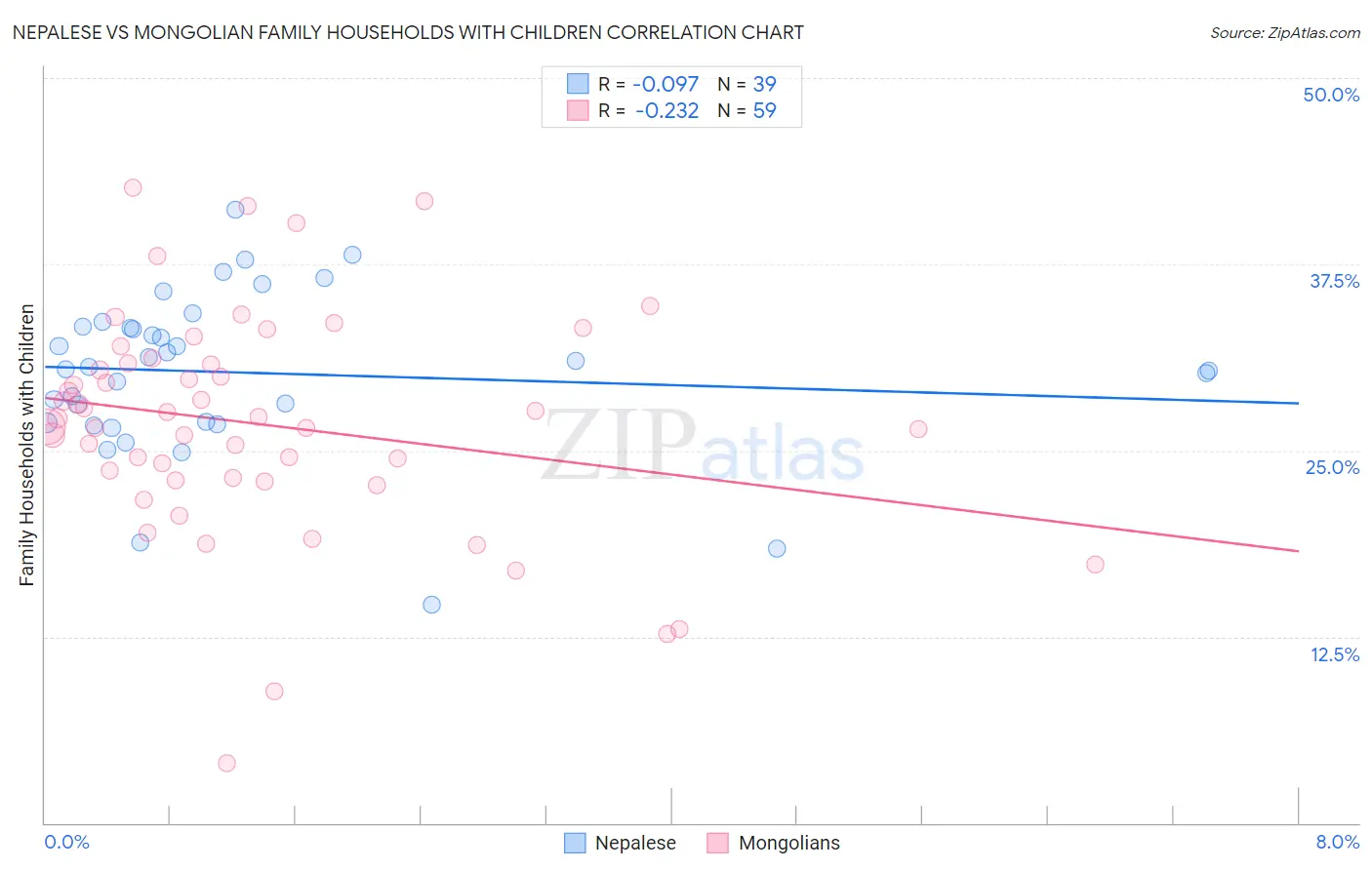Nepalese vs Mongolian Family Households with Children
COMPARE
Nepalese
Mongolian
Family Households with Children
Family Households with Children Comparison
Nepalese
Mongolians
30.5%
FAMILY HOUSEHOLDS WITH CHILDREN
100.0/ 100
METRIC RATING
11th/ 347
METRIC RANK
27.6%
FAMILY HOUSEHOLDS WITH CHILDREN
70.7/ 100
METRIC RATING
159th/ 347
METRIC RANK
Nepalese vs Mongolian Family Households with Children Correlation Chart
The statistical analysis conducted on geographies consisting of 24,519,269 people shows a slight negative correlation between the proportion of Nepalese and percentage of family households with children in the United States with a correlation coefficient (R) of -0.097 and weighted average of 30.5%. Similarly, the statistical analysis conducted on geographies consisting of 140,279,389 people shows a weak negative correlation between the proportion of Mongolians and percentage of family households with children in the United States with a correlation coefficient (R) of -0.232 and weighted average of 27.6%, a difference of 10.6%.

Family Households with Children Correlation Summary
| Measurement | Nepalese | Mongolian |
| Minimum | 14.7% | 4.0% |
| Maximum | 41.2% | 42.6% |
| Range | 26.5% | 38.6% |
| Mean | 30.2% | 26.7% |
| Median | 30.6% | 27.2% |
| Interquartile 25% (IQ1) | 26.8% | 23.0% |
| Interquartile 75% (IQ3) | 33.3% | 30.8% |
| Interquartile Range (IQR) | 6.5% | 7.8% |
| Standard Deviation (Sample) | 5.5% | 7.5% |
| Standard Deviation (Population) | 5.4% | 7.5% |
Similar Demographics by Family Households with Children
Demographics Similar to Nepalese by Family Households with Children
In terms of family households with children, the demographic groups most similar to Nepalese are Immigrants from Fiji (30.5%, a difference of 0.080%), Thai (30.6%, a difference of 0.40%), Yakama (30.8%, a difference of 0.88%), Immigrants from Pakistan (30.2%, a difference of 0.88%), and Afghan (30.2%, a difference of 1.1%).
| Demographics | Rating | Rank | Family Households with Children |
| Mexicans | 100.0 /100 | #4 | Exceptional 31.4% |
| Tongans | 100.0 /100 | #5 | Exceptional 31.2% |
| Immigrants | India | 100.0 /100 | #6 | Exceptional 31.0% |
| Immigrants | Central America | 100.0 /100 | #7 | Exceptional 31.0% |
| Yakama | 100.0 /100 | #8 | Exceptional 30.8% |
| Thais | 100.0 /100 | #9 | Exceptional 30.6% |
| Immigrants | Fiji | 100.0 /100 | #10 | Exceptional 30.5% |
| Nepalese | 100.0 /100 | #11 | Exceptional 30.5% |
| Immigrants | Pakistan | 100.0 /100 | #12 | Exceptional 30.2% |
| Afghans | 100.0 /100 | #13 | Exceptional 30.2% |
| Bangladeshis | 100.0 /100 | #14 | Exceptional 30.1% |
| Immigrants | South Central Asia | 100.0 /100 | #15 | Exceptional 30.0% |
| Immigrants | Afghanistan | 100.0 /100 | #16 | Exceptional 30.0% |
| Hispanics or Latinos | 100.0 /100 | #17 | Exceptional 29.9% |
| Salvadorans | 100.0 /100 | #18 | Exceptional 29.9% |
Demographics Similar to Mongolians by Family Households with Children
In terms of family households with children, the demographic groups most similar to Mongolians are Romanian (27.6%, a difference of 0.0%), Indian (Asian) (27.6%, a difference of 0.020%), Subsaharan African (27.6%, a difference of 0.080%), Alaskan Athabascan (27.6%, a difference of 0.090%), and Immigrants from Bangladesh (27.6%, a difference of 0.10%).
| Demographics | Rating | Rank | Family Households with Children |
| Ethiopians | 77.0 /100 | #152 | Good 27.6% |
| Immigrants | Cabo Verde | 75.6 /100 | #153 | Good 27.6% |
| Icelanders | 75.3 /100 | #154 | Good 27.6% |
| Comanche | 74.8 /100 | #155 | Good 27.6% |
| Hungarians | 74.6 /100 | #156 | Good 27.6% |
| Indians (Asian) | 71.6 /100 | #157 | Good 27.6% |
| Romanians | 70.8 /100 | #158 | Good 27.6% |
| Mongolians | 70.7 /100 | #159 | Good 27.6% |
| Sub-Saharan Africans | 67.5 /100 | #160 | Good 27.6% |
| Alaskan Athabascans | 67.1 /100 | #161 | Good 27.6% |
| Immigrants | Bangladesh | 67.0 /100 | #162 | Good 27.6% |
| Czechs | 65.3 /100 | #163 | Good 27.5% |
| Immigrants | Hong Kong | 64.9 /100 | #164 | Good 27.5% |
| Immigrants | South Africa | 61.3 /100 | #165 | Good 27.5% |
| Immigrants | Nonimmigrants | 61.2 /100 | #166 | Good 27.5% |